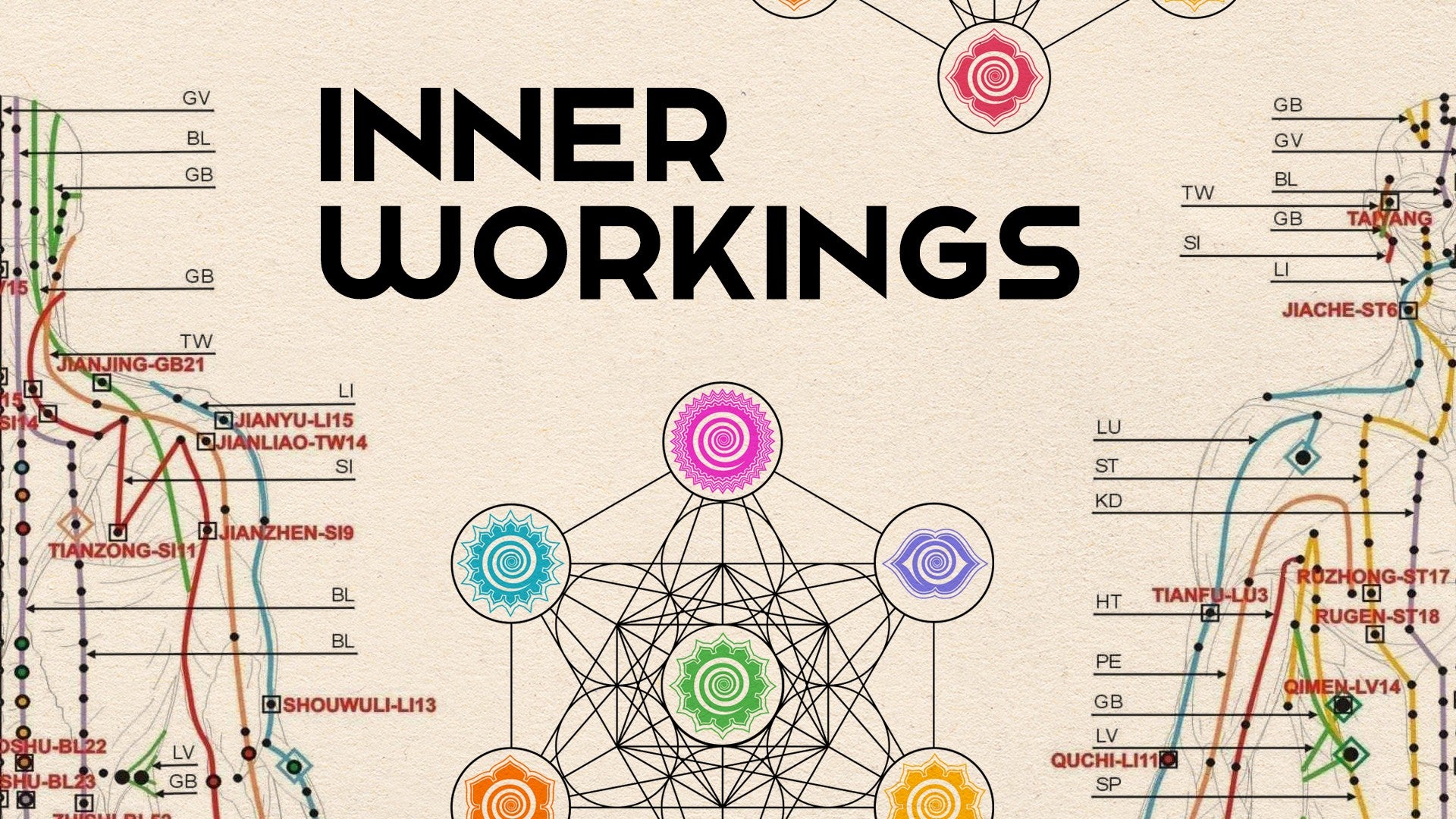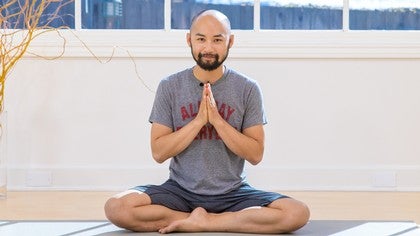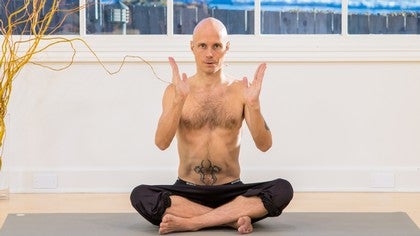Description
About This Video
Transcript
Read Full Transcript
Salutations. Namaste. This is a short tutorial to help support the three classes that I'm going to offer. One class is going to be for beginners. The second class will be for all levels with options for both beginners and intermediate or advanced practitioners. The third class will be an advanced practice. It's important for us to understand what is yoga before we begin. Yoga can mean a couple things which really mean the same thing in that yoga comes from the word to unite or to yoga to bring together to integrate or to add. That's the popular definition to unite, union. But the other meaning of yoga, yujir samadho, is meditative concentration or the ability to focus one's mind. In order for someone to focus their mind, in order for us to focus our minds, it needs to be calm and clear. Another definition of yoga can be that yoga is the space between our thoughts. It's mental quietude. The idea is to get to that place. In these three classes, we're going to use some tools to help us get there. The tools are the asanas or the postures, of course. But more importantly, it's the breath that we use within the postures and the transitions between the postures. We also use drishti, which is your gaze or focal point, your attentiveness or your attention. So for beginners, do your best to breathe through your nose. You may breathe through your mouth if you absolutely need to, but if you breathe through the mouth, try to breathe through your throat like this versus if you can do the ujjayi breathing or the victorious breath, it's like this. In through the nose and then out through the throat with your lips closed. You want to try to keep this quality of breathing throughout your practice, regardless of what level or experience level you're in. If you find yourself holding your breath, grunting through a pose, you need to back off and take it down a step so that you can maintain the quality of your practice. Yoga isn't about what you can do. It's about the quality that you do something with. I love that quote. Brian Kess said that. So the quality of your practice ultimately lies in the quality of your concentration and the quality of your breathing. So try to keep this as much as you can. The reason is the mind and the breath are partners. The mind will go and follow the breath. If you can't control the mind, then control your breath. And in my opinion, there's no other better way to control the breath than to do ujjayi breathing. Intermediate and advanced practitioners will hear me call out the bandhas or the internal locks. The jalandar bandha or the chin lock is the first one. It's simply pressing your chin to your chest, about four fingers below the collarbone. If you gaze at your navel, you'll do that. Those with reverse curvature in their cervical or a straight neck, it might be uncomfortable for you to do that. So if it's uncomfortable at any time or painful, you don't have to do it. And remember, your practice should feel good. If you're injuring yourself in your yoga practice, you're doing something wrong. That's what one of my teachers, David Williams, says. The second bandha is the udhyana bandha. It is the upward flying lock. Udhyana means upward flying. My teacher says if you're doing mula bandha correctly, you're sort of getting a two-for-one. So when you do the mula bandha, you pull the pelvic floor up, you squeeze your pubic coccygeal group of muscles. Like if you had to use the restroom and you didn't have one in sight, then you would squeeze these bathroom muscles. David Swenson says that. So you pull it in, but at the same time you pull your navel in and there's this a little bit of an upward lift. A true udhyana bandha is actually with a retention, a breath retention. You would actually hold your breath out, then pull it up. But that's not what I'm talking about. In our asana practice, usually you're breathing and you're maintaining an awareness below the navel, drawing the navel inward. So those are the three bandhas, jalandhar bandha, udhyana bandha, or if you're doing mula bandha correctly, you're getting the two-for-one. Now what are we doing when we're practicing these asanas? Well we're trying to heal the body one, but we're also trying to clear the mind and create a sattvic state. So I'd like to talk about the gunas really quickly here. The gunas are that which binds, or threads or rope. It means thread or rope.
These are invisible qualities that can be found through the entire universe, all of nature of praká¹?ti. And what they are, the qualities constituents, tamas. Tamas is the first quality we'll talk about, and tamas is the quality of heaviness or sluggishness, darkness. This can be found in material objects and as well as the mind. A tamasic object will be heavy. A tamasic mind will be slow, sluggish, confused, difficult to concentrate, doesn't make sense. A rajasic mind, rajas being the second guna we'll talk about, is the quality of rajas is thickliness or action or movement. And a rajasic object is one that is moving. It's got energy in. A rajasic mind is one that's constantly moving as well, moving from one object to another, a distracted mind. A rajasic mind cannot meditate, nor cannot tamasic mind. Only a sattvic mind can meditate, and sattva is a quality of clarity, knowledge, luminescence, an object that is sattvic is said to be light. And so what we're trying to do here is create a sattvic body and a sattvic mind, a mind that is clear, that can focus, that can meditate. And a sattvic body is one that is light, not necessarily light in weight, but light that, for example, after drinking alcohol is tamasic, your mind becomes cloudy and not as sharp. And you go to sleep and you wake up the next day and you feel very heavy. It's difficult to get out of bed. That's what I'm talking about. This heaviness, this feeling of sluggishness, that body becomes tamasic. Whereas if you went to bed early and you ate light and you wake up in the morning refreshed, you would bounce out of bed. Your body would be sattvic and your mind is clear. So that's all we're trying to do, is to create a more sattvic experience where the body feels light, the joints feel open, and the mind is easily focused on whatever object or subject that you'd like to focus on. So to recap, beginners do your best to maintain a quality of breath throughout your practice, the ujjayi breathing, with your lips closed, breathing through your throat like this. If you need to breathe through your mouth at any time, it's better to breathe through your throat like this versus like this. Secondly, try to keep your eyes in one spot when you're holding a pose. If your eyes are moving around, likely your mind is moving around as well. For intermediate and advanced practitioners, be mindful of your bandhas. Jalandhar bandha, mula bandha, udhyana, lift. Maybe the udhyana bandha if I call to hold the breath and pull the belly in and up. And finally, the gunas, we're trying to balance out the gunas or really reduce the vrajasic tendencies and the tamasic tendencies, the sluggishness, the confusion, the darkness, and the activity so that we can become clear and full of knowledge and able to focus and meditate. And with that, let's go ahead and get started with our practice. Namaste.






You need to be a subscriber to post a comment.
Please Log In or Create an Account to start your free trial.